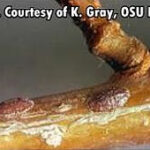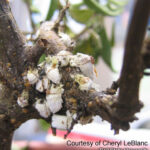Some Background
Scale species are broken down into several families, of which we will discuss three major ones. These three distinct families are Coccidae, which are brown soft scale and cottony maple scale; Diaspididae, which are armored scales such as San Jose scale and pine needle scale; and Pseudococcidae, which, of course, are mealybugs.
How They Become a Problem
So wide is the distribution and concern of these pests, two are mentioned on the site (History of Biocontrol and IPM) in which we mentioned two scale insects: the cottony cushion scale, Icerya purchasi (of the family Magarodidae — which will not be discussed on this page) and the cassava mealybug (again, of the family Pseudococcidae).
Scales, such as the euonymus scale, are sedentary creatures that are difficult to control — especially with sprays — as most have a natural talent for self-preservation.
First of all, most of these pests, at least as female scales, permanently attach themselves to the plant or tree that plays host to them.
Secondly, most are equipped with a scale covering, usually composed of waxy secretions forming either a shell of sorts or a dense mat of waxy filaments or fuzz.
These characteristics contribute to them being very troublesome and difficult to control.
Scale insects affect many different plant species, shrubs, and woody plants. Most herbaceous greenhouse crops — especially those whose production cycle is short, i.e., bedding plants-may never become afflicted with scale insects.
More enduring crops, such as tropical foliage, trees, etc., are far more likely to see these pests — especially if they are under duress. Most often, we find that tropical indoor plants and interiorscape plantings fall victim to these pests.
This is due to these plantings, as the name interiorscape suggests, being indoors and subjected to stresses that are not of the natural kind they are usually subjected to.
In other words, if a tropical palm tree that has grown in the bright, warm and humid outdoor climate of Florida gets relocated to a dimly lit, stagnating, warm and dry climate in a Milwaukee, Wisconsin mall, it will be stressed and very likely to develop a scale insect infestation.
It may, perhaps, have some scale insects of its own, which begin to take over when the plant becomes stressed as it tries to acclimate to its new surroundings.
Very often, though, scales naturally present in Wisconsin will be drawn to these plants during the summer months as, to them, they probably look like easy-pickin’s and will, therefore, try to get to these plants.
Outdoors, even in Wisconsin, natural enemies would normally keep scales in check least on native plants and trees. Where this often doesn’t work is in a situation where the scales or plants are not indigenous to the region, in which case they may lack natural enemies and vigor.
Another situation where scale insects can become problematic may be in mass agriculture. Take, for instance, the citrus groves of Florida and California. These groves are often under constant assault from pesticides, thus reducing the native population of biocontrol agents.
If the sprays were not applied, assuming we’re talking about an indigenous pest, the natural enemies would often be capable of restoring balance.
Unfortunately, many growers will not allow this natural transition to take place as the lag time required for the natural enemies to play catch up could come at too high a cost. However, since many of the pests are from out-of-town, we’d have to also introduce out-of-town biocontrols. Just like that which was done to combat the cottony cushion scale.
Scales take up residence on fruits and stems and leaves — everywhere and anywhere. And as we wrote, they are well protected. In other words, heavy spraying must be done in order to penetrate their defenses.
Most of the spraying, it seems, does little good unless applied heavily enough to actually smother these insects, but which, of course, is often repelled by the waxy secretions. (Horticultural oil is a good remedy against scales if smothering is the cure de jour.
Unfortunately it is not conducive to plant health as it smothers the plants as well.) This is why biocontrols are such a logical choice when it comes to battling these tenacious pests indoors. The tricky part is finding the right parasitoid or predator to do the job and allowing it enough time to work.
If time is given and sprays are not applied, natural enemies do work, especially if the pest is indigenous.
If scales are not introduced by way of transportation of the pests with the plants, then they will come from the surrounding habitat — albeit slowly. Since only the adult males have wings it doesn’t seem likely or logical that they begin the infestation process.
Our thought is that the immature or crawler stages, which are mobile, slowly spread the population to other hosts. In addition to crawling, we suspect some hitch rides on water runoff, wind, people and animals and the like.
Remember to scout new plant material thoroughly before bringing it into your greenhouse or interiorscape account. At least that may prevent the one factor most likely to spread these pests from ever occurring.
A Serious Pest

Scales can cause considerable economic damage. They, like aphids, have a proboscis, stylet or straw-like mouthpart, which they insert into the phloem or inner cells of a plant.
Upon insertion, the scales draw the plant’s juices or sap. This feeding activity generally goes unnoticed until the plant or tree weakens and dies.
At this point, the subject may be beyond the self-reparation stage. It is, therefore, imperative the scout notice the pests and begin corrective actions before the plant shows outward signs.

The presence of the scales will make a plant unsalable. Soft scales will generally appear as bark-colored bumps on the twigs and leaves. With close scrutiny, any quasi-talented scout will notice them. Mealybugs are typically whitish in color and can, too, be very noticeable.
In addition to the mealybugs themselves, one may notice their cottony egg masses, which are produced by most mealybug species, though not all (long-tailed mealybugs, for instance, reproduce viviparously, giving birth to live young, making egg masses obsolete).
Armored scales are generally very small and are the most difficult to detect. However, in most interiorscape and greenhouse situations, we’ve found the most common scale insects are soft-scales and mealybugs.
Though armored scales do indeed make their mark in these types of plantings, they generally seem to be more of a problem on citrus and other trees and shrubs.
Some Advice on Scale Insects and Mealybugs
This excrement is known to attract sugar-feeding ants, which may, in an effort to manage their food source, protect them from biocontrols, natural and introduced. This last condition, if the scale population grows large enough to support ants, can make non-chemical control even more challenging.
Armored scales do not produce honeydew, so this isn’t a factor to be concerned with when dealing with them. This little information, though, can help you with the identification process.
Scouting Scale Bugs on Plants
One to three-millimeter specks with no honeydew may indicate the presence of armored scales (and both soft and armored scales have hard outer coverings, so don’t be confused by the names).
Three to seven-millimeter white insects with shiny, sticky honeydew and cottony egg masses (in most cases) may mean you have mealybugs.
Unless they’re root mealybugs, which look like their above-ground counterparts but are extremely difficult to control and can only be found within the root ball and crown, they should be readily apparent and easily identifiable.
Scales can be extremely difficult pests to deal with — especially if you’re in a hurry — as chemical or biological control can take a while.
Based on our experiences with growers, mealybugs are the easiest to detect, the most common, and the simplest to control biologically. Remember: scout well and detect them as early as possible for the best results.
Some Solutions
The predators tend to be opportunistic and provide faster results to a wider selection of pests. However, they don’t stay in place as long, thus shortening the control period. They will usually, except in the most ideal conditions, require multiple reapplications at maintenance intervals.
Often, the best thing you can do is simply put the plant outside and let Mother Nature pick the predator or parasitoid for you.
